- SAPUI5 Version 1.122
- SAPUI5 Version 1.120
- SAPUI5 Version 1.118
- SAPUI5 Version 1.116
- SAPUI5 Version 1.114
- SAPUI5 Version 1.112
- SAPUI5 Version 1.110
- SAPUI5 Version 1.108
- SAPUI5 Version 1.106
- SAPUI5 Version 1.104
- SAPUI5 Version 1.102
- SAPUI5 Version 1.100
- SAPUI5 Version 1.98
- SAPUI5 Version 1.96
- SAPUI5 Version 1.94
- SAPUI5 Version 1.92
- SAPUI5 Version 1.90
- SAPUI5 Version 1.88
- SAPUI5 Version 1.86
- SAPUI5 Version 1.84
- SAPUI5 Version 1.82
- SAPUI5 Version 1.80
- SAPUI5 Version 1.78
- SAPUI5 Version 1.76
- SAPUI5 Version 1.74
- SAPUI5 Version 1.72
- SAPUI5 Version 1.70
- SAPUI5 Version 1.68
- SAPUI5 Version 1.66
- SAPUI5 Version 1.64
- SAPUI5 Version 1.62
- SAPUI5 Version 1.60
- SAPUI5 Version 1.58
- SAPUI5 Version 1.56
- SAPUI5 Version 1.54
- SAPUI5 Version 1.52
- SAPUI5 Version 1.50
- SAPUI5 Version 1.48
- SAPUI5 Version 1.46
- SAPUI5 Version 1.44
- SAPUI5 Version 1.42
- SAPUI5 Version 1.40
- SAPUI5 Version 1.38
- SAPUI5 Version 1.36
- SAPUI5 Version 1.34
- SAPUI5 Version 1.32
- SAPUI5 Version 1.30
- SAPUI5 Version 1.28
- SAPUI5 Version 1.26
- Latest SAPUI Version 1.124
- SAPUI5 Version 1.122
- SAPUI5 Version 1.120
- SAPUI5 Version 1.118
- SAPUI5 Version 1.116
- SAPUI5 Version 1.114
- SAPUI5 Version 1.112
- SAPUI5 Version 1.110
- SAPUI5 Version 1.108
- SAPUI5 Version 1.106
- SAPUI5 Version 1.104
- SAPUI5 Version 1.102
- SAPUI5 Version 1.100
- SAPUI5 Version 1.98
- SAPUI5 Version 1.96
- SAPUI5 Version 1.94
- SAPUI5 Version 1.92
- SAPUI5 Version 1.90
- SAPUI5 Version 1.88
- SAPUI5 Version 1.86
- SAPUI5 Version 1.84
- SAPUI5 Version 1.82
- SAPUI5 Version 1.80
- SAPUI5 Version 1.78
- SAPUI5 Version 1.76
- SAPUI5 Version 1.74
- SAPUI5 Version 1.72
- SAPUI5 Version 1.70
- SAPUI5 Version 1.68
- SAPUI5 Version 1.66
- SAPUI5 Version 1.64
- SAPUI5 Version 1.62
- SAPUI5 Version 1.60
- SAPUI5 Version 1.58
- SAPUI5 Version 1.56
- SAPUI5 Version 1.54
- SAPUI5 Version 1.52
- SAPUI5 Version 1.50
- SAPUI5 Version 1.48
- SAPUI5 Version 1.46
- SAPUI5 Version 1.44
- SAPUI5 Version 1.42
- SAPUI5 Version 1.40
- SAPUI5 Version 1.38
- SAPUI5 Version 1.36
- SAPUI5 Version 1.34
- SAPUI5 Version 1.32
- SAPUI5 Version 1.30
- SAPUI5 Version 1.28
- SAPUI5 Version 1.26
Upload Set
sap.m.UploadSet
Intro
The upload set control allows users to upload single or multiple files from a device (desktop, tablet, or phone) to an SAP Fiori app.
Despite its name, the upload set is not limited to upload scenarios. Depending on the context or the access rights, some users may only be allowed to download the files uploaded by others. You can use the upload set control for both cases.
When to Use
Use the upload set control if:
- You want to show a list of uploaded files that can be modified.
- You want to allow users to add or remove several files, and to change the file names.
- You are still using one of the older upload controls:
sap.ca.ui.FileUploadsap.m.UploadCollection(deprecated since SAPUI5 version 1.88)
Do not use the upload set control if:
- The user can upload only one file to the app. In this case, use the
sap.ui.unified.FileUploadercontrol instead.
Components
List
Actions (2)
By default, each item has an Edit button and a Delete button . Edit turns the title into an editable field so the item can be renamed.
Technical statuses (3)
Technical statuses are not bound to a workflow or business process. They are mainly used to show the current editing status of an object (Draft, Locked, Unsaved Changes). For further uses and more details, see Object Display Components and Draft Handling.
Attributes and statuses (4)
You can display additional attributes and statuses below the file name. Attributes or statuses can include the name of the person who uploaded the file, the upload date, the version number, file size, and the object state in a workflow (such as “Approved” or “Overdue”).
Statuses can be shown in different colors, based on the visual guideline for semantic colors.
If multiple attributes or statuses are displayed, they are separated by a bullet.
Behavior and Interaction
Uploading Files
The upload set offers two basic working modes:
- Instant upload (default): Files are uploaded as soon as they the user drops them onto the control or clicks the OK button in the file selection dialog.
- Manual upload: All added files are first collected in the front-end list, where the user needs to trigger the upload.
If some users are only allowed to download the files uploaded by others, you can disable the upload option.
Unlike the deprecated Upload Collection control, the Upload Set control allows you to use a custom uploader.
Drag and Drop
Users can easily select one or multiple files from their computer and drag them onto the upload set to start the upload.
As the user hovers over the drop zone, a border appears around the upload set to indicate that the file can be released.
The upload process itself is the same as if a file had been added via the Upload button.
Opening Files
Files are opened by clicking the file name of the attachment. How the files open depends on the operating system and browser settings.
On desktop devices, clicking the file name opens the program that has been assigned to this file type. In some cases, the files are opened directly in the browser if they are among the supported file types, like jpg, png or pdf. However, this also depends on the individual browser and its settings.
Mobile devices usually open a dialog in which the user can select an app that supports the respective file type.
Renaming Files
The Edit function works identically on desktop and mobile devices.
- The user clicks the Edit button .
- The file name becomes an input field in which the existing name is highlighted. The icon buttons for Edit and Delete are replaced by two text buttons: Rename and Cancel.
- When the user starts typing, the highlighted text is overwritten. Alternatively, the user can use the mouse or keyboard to change the selected text.
- The new file name can be validated in two ways:
- The user clicks Rename.
- The user presses Enter.
Deleting Files
The Delete function works identically on desktop and mobile devices.
After clicking the Delete button for a file, the user is prompted to confirm the deletion.
Delete confirms the deletion and the file is removed from the list. Cancel aborts the process, closes the dialog, and brings the user back to the file list without making any changes. For more information on the pattern, see Message Box – Confirmation for “Delete”.
Clickable Attributes
Object attributes can be made clickable. This can be very helpful to provide users with a direct way to access certain information, such as a person’s profile and contact data, or the version history of a file.
Examples:
- Uploaded By: John Miller
- Last Edited By: Donna Moore
- Version 1.1
Example
You can use the upload set control whenever users need to be able to upload multiple files. The example below shows the object page of a product, in this case a machine, with an Attachments tab containing several documents relating to the material specification and requirements.
Other possible scenarios:
- Warranty claim: Users need to upload images of a damaged item.
- Product details: Editors can upload product pictures that will be shown in the online shop.
- Service history: Whenever maintenance is carried out, the service worker attaches a document to the object.
Top Tips
When to Show, Disable, and Hide Actions
The Edit button and Delete button are visible and enabled by default. If you don’t want to allow users to edit or delete uploaded files, hide the corresponding buttons.
Don’t leave buttons enabled and then show an error message when the function isn’t available.

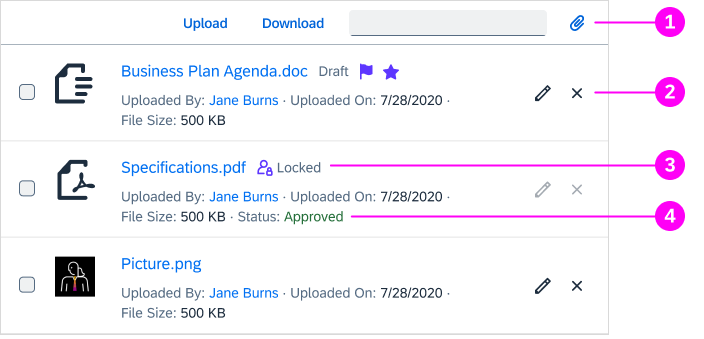
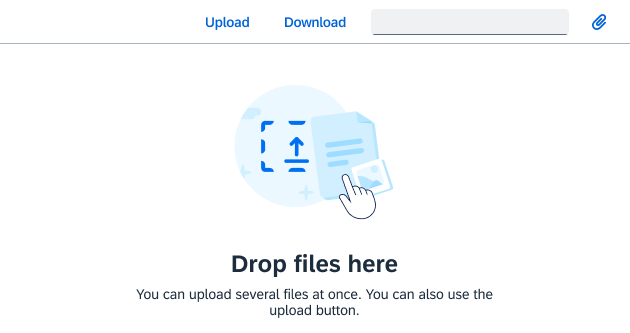
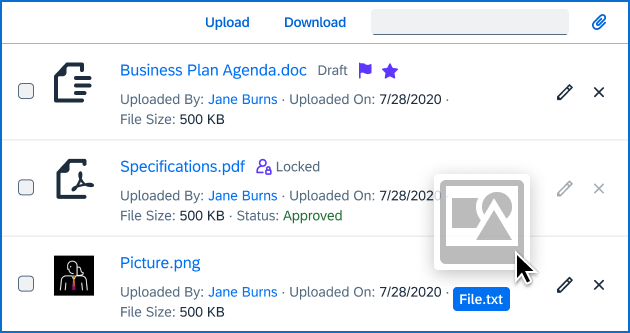
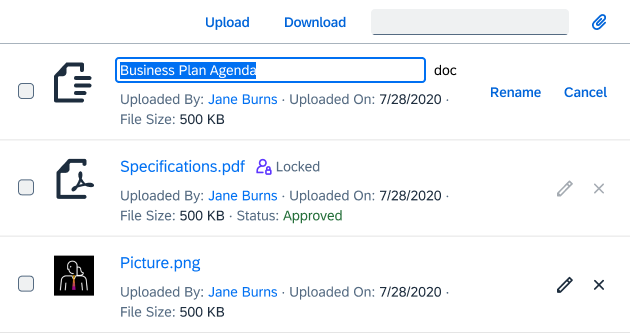
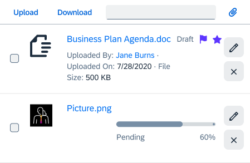
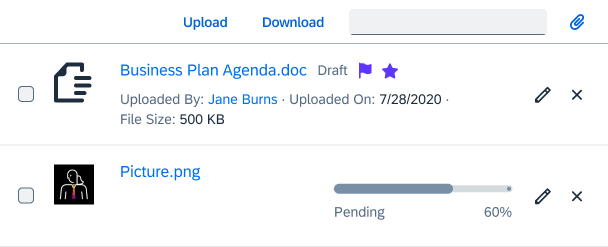

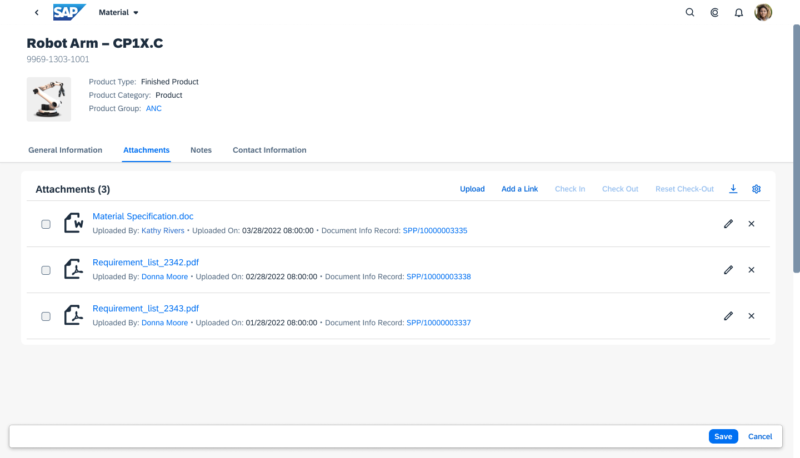

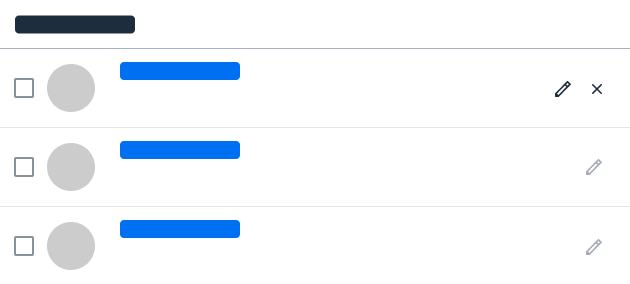
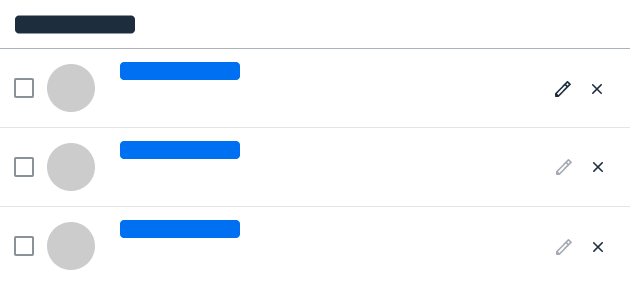
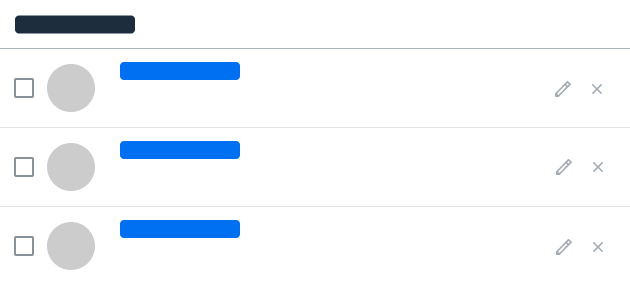
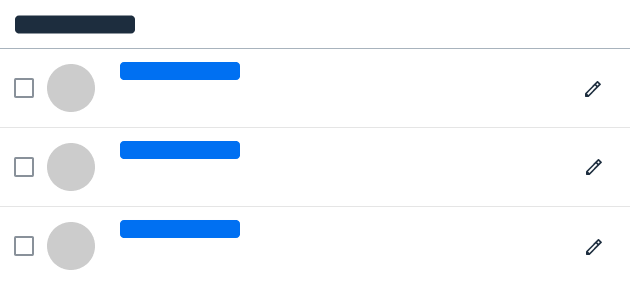
 Your feedback has been sent to the SAP Fiori design team.
Your feedback has been sent to the SAP Fiori design team.